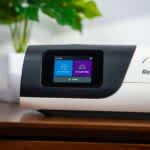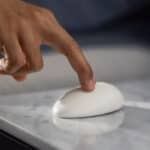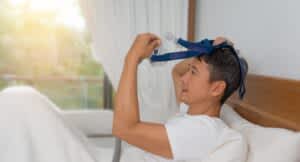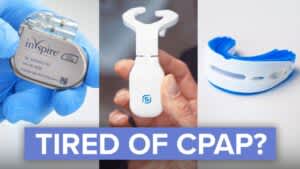Medical Disclaimer: The following content should not be used as medical advice or as a recommendation for any specific supplement or medication. It is important to consult your health care provider prior to starting a new medication or altering your current dosage.
People often use the general term “sleep apnea” in reference to two sleep disorders, obstructive sleep apnea (OSA) and central sleep apnea (CSA). Although both disorders are associated with older age, they may also occur in infants and children. In fact, an estimated 2% to 5% of children have OSA.
It is important to identify and treat both types of sleep apnea in children. Untreated childhood OSA is associated with learning and behavior issues and, in more severe instances, reduced growth and heart-related problems. We explore signs of sleep apnea in kids, potential causes, treatments, and when to talk to a doctor.
What Is Sleep Apnea?
Obstructive sleep apnea is characterized by pauses and reductions in breathing during sleep due to a blocked airway. Central sleep apnea also involves pauses and reductions in breathing during sleep. In contrast, lapses in breathing associated with CSA are caused by the brain not properly signaling the lungs to breathe rather than by airway obstructions.
What Are the Signs of Sleep Apnea in Children?
Children with obstructive sleep apnea may display a variety of symptoms, including:
- Snoring
- Pauses in breathing or gasping while asleep
- Sleeping in unusual positions
- Daytime sleepiness
- Hyperactivity
- Behavior problems
- Reduced school performance
- Mood changes and irritability
- Night sweats
- Morning headaches
- Daytime mouth breathing
- Wetting the bed
- Difficulty swallowing while awake
Central sleep apnea occurs less commonly in children and is usually associated with an underlying health condition. When an infant experiences CSA, others may see them stop breathing for 20 or more seconds at a time while asleep. Often, children with CSA also have OSA, and their symptoms may be more severe than those who have OSA alone.
What Can Cause Sleep Apnea in Children?
Multiple factors may increase a child’s risk of developing OSA.
- Enlarged tonsils and adenoids: The size and placement of a child’s tonsils and adenoids, which are groups of tissue in the throat, can impact their risk of OSA. Larger tonsils can block the airway, as can smaller tonsils, depending on their placement.
- Obesity: Like adults, children that are obese face an increased risk of OSA. Studies show that obesity and OSA are closely linked in adolescents especially.
- Health conditions: The presence of certain disorders that affect airway size or the ability to control the airway increase a child’s likelihood of developing OSA. For example, experts recommend checking children with cerebral palsy, Down syndrome, muscular dystrophy, and other disorders for signs of OSA.
- Orthodontic issues: Certain problems with a child’s teeth or bite may make developing OSA more likely. For example, having a crossbite or if the roof of the mouth is high and narrow, airway obstructions could be more likely.
- Family history: Children face an increased risk of developing OSA if family members have a history of OSA. Experts suggest this increase could be due to genetics affecting the body’s shape, as well as the way a person breathes. However, studies have not examined how living in a shared environment may play a role.
- Smoke exposure: Being exposed to tobacco smoke, such as that from cigarettes, cigars, or tobacco pipes, is linked to the development of both OSA and snoring.
Although OSA can occur in children of any age, it happens more commonly in certain groups. Of those who do not have an underlying health condition, preschool-aged children with enlarged tonsils and adolescents with obesity are the children most likely to experience OSA.
Central sleep apnea in children has not been studied as widely as OSA, making it more difficult to identify risk factors. That said, limited research suggests CSA occurs more commonly in younger children and in children who have moderate or severe OSA.
In infants, CSA is associated with acid reflux, undergoing anesthesia, and viral infections. CSA occurs more often in infants born prematurely, but it resolves in nearly all of them within weeks after reaching their projected due date.
Diagnosing Sleep Apnea in Children
When doctors suspect obstructive sleep apnea in a child at a routine appointment, they may ask caregivers if the child snores. If the doctor learns that a child snores three or more nights each week, snores loudly, or experiences breathing pauses during sleep, the doctor will likely conduct or order an evaluation for OSA.
Doctors may also recommend OSA testing for children who experience hyperactivity, tiredness, learning difficulties, or problems with behavior.
When a doctor evaluates a child for OSA, they generally ask questions about the child’s sleep history and conduct a physical examination that involves looking at the nose, mouth, and throat. They may also refer a child to a sleep specialist or ear, nose, and throat specialist for further evaluation.
Children suspected of having OSA are often asked to undergo a sleep study, also called polysomnography. The sleep study occurs overnight, in a sleep lab or hospital. Through a sleep study, health care providers can monitor how often a child stops or slows their breathing during sleep to determine if they have OSA.
Sleep studies also often monitor and record brain activity, heart rate, and blood oxygen levels. To gather these measurements, a sleep technician places censors on the child’s eyelids, face, chest, arms, legs, finger, and scalp before they go to sleep.
Although a sleep study is the standard tool used to diagnose OSA in children, a doctor may order other tests if for some reason a child cannot undergo a sleep study. These other tests may include a home sleep apnea test, an in-lab study of nap-time sleep, and analysis of video or audio recordings of the child sleeping.
Doctors also generally order an in-lab sleep study when they suspect a child may have central sleep apnea. A sleep study is required to diagnose CSA. The home sleep apnea tests sometimes used to diagnose OSA cannot be used to diagnose CSA.
When a child is thought to have CSA, doctors may also recommend other tests that aren’t commonly used for OSA. For example, they may order genetic testing to look for certain genetic mutations or order a scan of the head and neck to look for potential issues with the brain and brainstem.
Once testing is complete, the doctor studies the test results. They then create an appropriate treatment plan if the child has been found to have a sleep-related breathing disorder such as OSA or CSA.
What Is the Treatment for Sleep Apnea in Children?
When a doctor diagnoses a child with a type of sleep apnea, there are several treatments they may consider.
Surgery
Children with OSA may have their tonsils and adenoids removed in a procedure called an adenotonsillectomy. The decision to remove a child’s tonsils and adenoids is made based on the size of the tonsils and adenoids, the child’s age, their symptoms, and the presence of any other health issues.
When a child with OSA has oversized tonsils and adenoids, removing them usually results in improved OSA symptoms. The surgery helps by reducing or eliminating airway blockages caused by the oversized tonsils and adenoids. The procedure has also been found to particularly help children who are obese or have severe OSA symptoms.
Sometimes children with OSA have abnormalities in the face or skull that may result in airway blockages that cannot be explained by tonsils and adenoids alone. In these instances, other surgeries might be required, such as surgery to reduce tongue size or surgery to remove tissue from other parts of the mouth or throat.
In studies of children who have both OSA and central sleep apnea, removal of the tonsils and adenoids has been found to usually improve or eliminate CSA symptoms as well. If a child has CSA and an underlying brain or brainstem disorder, their CSA symptoms may be improved by surgery aimed at correcting the underlying disorder.
Watchful Waiting
Doctors do not always immediately recommend surgery or other treatment for children with OSA. Instead, they may suggest “watchful waiting” for children who have OSA that is categorized as mild or moderate. Watchful waiting involves holding off on treatment for up to six months before reevaluating the child. Watchful waiting isn’t recommended for children with severe OSA.
While practicing watchful waiting, alternative methods might be tried. For example, a child may be referred to other types of specialists to treat other disorders, like asthma or allergies. Caregivers may also receive education about healthy sleep habits. In some cases, a doctor may suggest that a child try a saline spray for nasal dryness.
PAP Therapy
When a caregiver doesn’t want a child with OSA to undergo surgery or the child doesn’t have oversized tonsils and adenoids, doctors may recommend positive airway pressure (PAP) therapy. PAP therapy may also be recommended for some children with CSA.
PAP therapy involves sleeping while connected to a PAP device, such as a continuous positive airway pressure (CPAP) machine or a bilevel positive airway pressure machine (BiPAP). These PAP machines release gentle, continuous air into a mask that covers a person’s nose or both their mouth and nose to keep their airway open as they sleep.
It may take time for a child to get used to PAP therapy. Health care workers can help caregivers and children find the PAP mask that makes the child feel most comfortable. They can also adjust the air pressure or recommend a different PAP machine to suit the child’s needs.
Although it may be challenging for children to regularly use a PAP machine each night, experts have discovered that even using a CPAP machine for just three hours a night can improve children’s OSA symptoms. In fact, after only three months of regular CPAP use, researchers noticed improvements in children’s attention, behavior, and daytime sleepiness.
Orthodontics
Preteen children with OSA who have a narrow palate may be candidates for an orthodontic treatment called rapid maxillary expansion (RME). RME involves expanding both the palate and the nasal passages to increase airway space. Only orthodontists who are experienced in treating children with sleep-related breathing disorders should oversee RME treatment.
Oral Appliances
Sometimes oral appliances are used to treat OSA by moving the tongue or jaw forward, which can help open the airway. Oral appliances as OSA treatments haven’t been widely studied in children, but they may be considered if other treatments fail. Finding a dentist with experience using oral appliances in children could be difficult in some areas.
Medication
When a child’s OSA seems to stem from allergies or oversized adenoids, two to four weeks of corticosteroid or antiinflammatory drugs might be tried. This trial period can help doctors determine if the medication might be a viable long-term treatment for the child, or if it could be used alongside other treatments, like surgery or PAP therapy.
In children who have CSA that is not due to an underlying cause, certain medications may be prescribed to help increase breathing during sleep. In premature infants with CSA, caffeine may be used as a medication. However, caffeine therapy is usually not recommended once the infant has passed what would have been their projected due date.
Other Treatments
Doctors may provide a referral to a nutritionist or weight reduction program to help with weight loss in cases where a child’s OSA is associated with weight gain. For those with severe obesity, doctors may recommend surgery.
If a child with OSA is exposed to allergens or tobacco smoke in their environment, they may benefit from avoiding potentially irritants. These pollutants can lead to nasal congestion that contributes to a narrowed airway.
Doctors may also recommend children try positional therapy, which involves not sleeping on one’s back in order to try and reduce OSA symptoms. Tools, like specially made pillows and belts, exist to help keep children from rolling onto their backs while asleep. Positional therapy may help because OSA symptoms are generally worse during back sleeping.
Health Risks of Childhood Sleep Apnea
When children with OSA are not treated for the disorder, they face multiple health risks. For example, severe OSA can interfere with a child’s ability to grow and reach developmental milestones.
Children who live with untreated sleep apnea may display behavioral issues such as aggression, hyperactivity, inattention, rebelliousness, and lack of impulse control. Daytime tiredness is also common.
Untreated OSA in children can also lead to heart-related problems. For example, children may develop high blood pressure and certain kinds of heart failure.
When to Talk to a Doctor
Contact your child’s doctor if you suspect your child has difficulty breathing during sleep or displays other symptoms of sleep apnea. Children living with sleep apnea may exhibit a variety of symptoms. For example, they may snore or gasp during sleep, experience daytime tiredness, act hyperactive, wake often to use the bathroom at night, or have morning headaches.
Frequently Asked Questions About Sleep Apnea in Children
Parents and caregivers should take their children to see a doctor if they suspect sleep apnea rather than attempt natural treatments at home. Individual children have sleep apnea for different reasons and must undergo a medical evaluation to determine the best treatment for their unique situation.
Although treatments like weight loss, removing environmental pollutants, or changing a child’s sleep position may help, children with OSA commonly require surgery or another treatment like PAP therapy.
Children prescribed CPAP therapy should use the CPAP machine every night and also when they take naps, unless their doctor or sleep specialist suggests otherwise.
Many children with obstructive sleep apnea have enlarged tonsils or adenoids. For this reason, some children with OSA breathe through their mouths even when they are awake.
Yes, infants can develop obstructive sleep apnea. Researchers estimate premature infants have four times the risk of developing OSA compared to infants that are not born prematurely.
References
Ask the Sleep Doctor
Have questions about sleep? Submit them here! We use your questions to help us decide topics for articles, videos, and newsletters. We try to answer as many questions as possible. You can also send us an email. Please note, we cannot provide specific medical advice, and always recommend you contact your doctor for any medical matters.









































